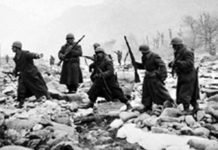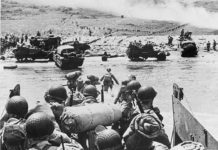The United States Air Force rejection of the F-107 as its next tactical fighter bomber is considered one of the greatest military blunders of all time.
When the Air Force (USAF) open up its design competition for a fighter bomber in the 1950s, North American proposed the F-100 based, but radically innovative F-107 Ultra Sabre. The USAF ended up picking the Republic F-105 Thunderchief, a craft that, due to its size and early troubles was not well received by the pilots.
Need for a New Plane
Technological advances and modern warfare requirements made it necessary for the USAF to acquire a new fighter bomber.
Taking advantage of its highly successful F-100 platform, North American Aviation initiated a series of sweeping changes in the design to meet the Air Force’s new specifications.
The projected North American plane would include an inside weapons compartment in the lower part of the fuselage; six hard points under the wings for bombs, missiles or gas tanks and posses air refueling capabilities.
As opposed to North American’s earlier designs – the F-86 and the F-100 – the F-107 would not have the air intake on the nose. That was now covered with the more common nose cone, housing radar and other sensory equipment.
The F-107s air intakes were experimental, controlling the air supply to the engines, and unusually placed in top of the fuselage, above and behind the pilot. This odd arrangement earned the craft the nickname of “man eater.”
The wings and tail design were identical to the F-100’s.
Testing and Cancellation
On September 10, 1956, the fist F-107 took off for testing. It achieved speeds of Mach 1.03. A little under two months later it would reach Mach 2, or twice the speed of sound. Two more prototypes were built.
Then, the USAF held a head to head competition between the F-107 and the F-105.
While the F-105 had a larger bomb load capability, the F-107 had a higher service ceiling and rate of climb as well as a longer range. Maximum speed and defending armaments were similar.
Intangibles went to the F-107. Pilots felt more comfortable in the smaller plane and, for many of them, it was easier to maneuver. Furthermore the F-100 relationship made the F-107 familiar to the aviators.
USAF, however, selected the Thunderchief as the next generation fighter bomber for the Tactical Air Command.
The F-107 project was cancel. The two remaining aircraft – for one had crashed – became research vehicles.
From the beginning, there was criticism about the choice, for the Thunderchief, while a good plane, never reached the revered status of the North American previous products.
Some of the criticism was proved right when about half of the F-105s that served in the Vietnam War were shot down. American aviators called it “Thud’ and “Lead Sled” among many other insulting monikers.
The F-107 prototypes that endure are on exhibit: one near Dayton Ohio, at the National Museum of the United States Air Force and the other in the Pima Air and Space Museum of Tucson, Arizona.
Sources:
- F-107 General Specifications
- The F-107 vs.the F-105








